Developer Guide
- Acknowledgements
- Setting up, getting started
- Design
- Implementation
- Documentation, logging, testing, configuration, dev-ops
- Appendix: Requirements
- Appendix: Instructions for manual testing
- Appendix: Planned Enhancements
Acknowledgements
- This document is based on the AddressBook-Level3
Setting up, getting started
Refer to the guide Setting up and getting started.
Design
.puml files used to create diagrams in this document docs/diagrams folder. Refer to the PlantUML Tutorial at se-edu/guides to learn how to create and edit diagrams.
Architecture
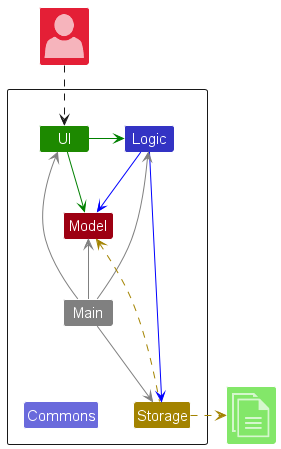
The Architecture Diagram given above explains the high-level design of the App.
Given below is a quick overview of main components and how they interact with each other.
Main components of the architecture
Main (consisting of classes Main and MainApp) is in charge of the app launch and shut down.
- At app launch, it initializes the other components in the correct sequence, and connects them up with each other.
- At shut down, it shuts down the other components and invokes cleanup methods where necessary.
The bulk of the app’s work is done by the following four components:
-
UI: The UI of the App. -
Logic: The command executor. -
Model: Holds the data of the App in memory. -
Storage: Reads data from, and writes data to, the hard disk.
Commons represents a collection of classes used by multiple other components.
How the architecture components interact with each other
The Sequence Diagram below shows how the components interact with each other for the scenario where the user issues the command delete person 1.
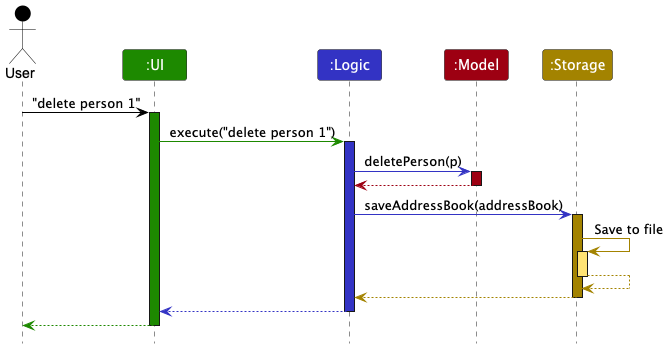
Each of the four main components (also shown in the diagram above),
- defines its API in an
interfacewith the same name as the Component. - implements its functionality using a concrete
{Component Name}Managerclass (which follows the corresponding APIinterfacementioned in the previous point.
For example, the Logic component defines its API in the Logic.java interface and implements its functionality using the LogicManager.java class which follows the Logic interface. Other components interact with a given component through its interface rather than the concrete class (reason: to prevent outside component’s being coupled to the implementation of a component), as illustrated in the (partial) class diagram below.
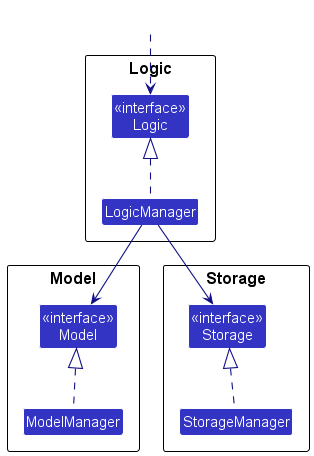
The sections below give more details of each component.
UI component
The API of this component is specified in Ui.java
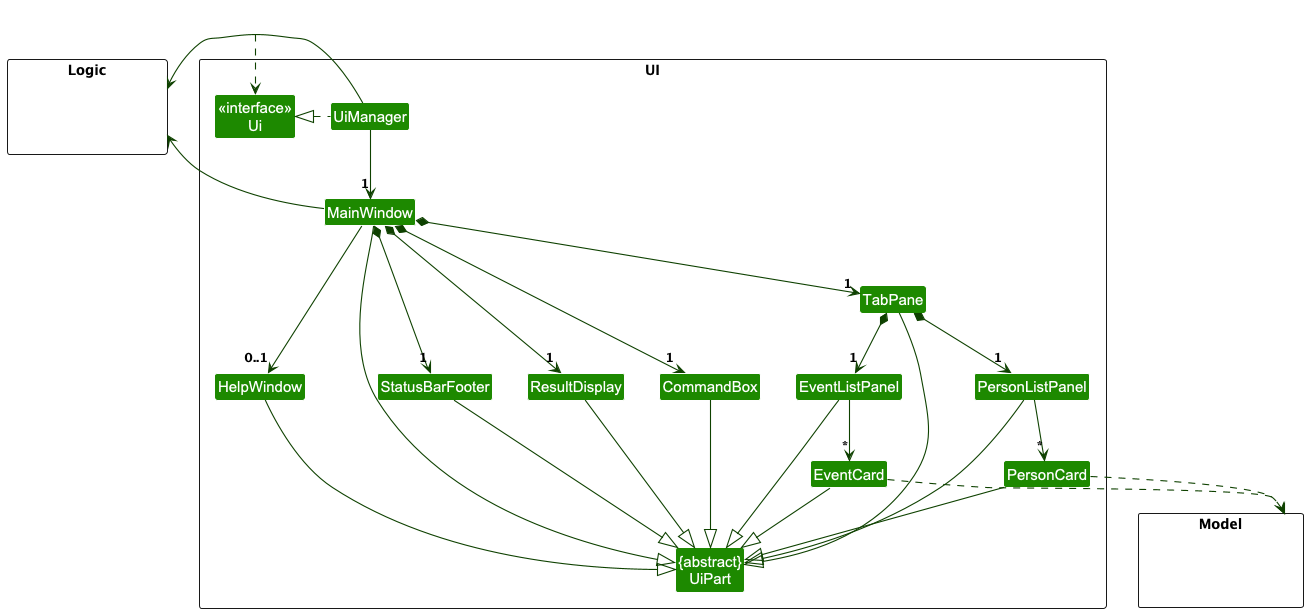
The UI consists of a MainWindow that is made up of parts e.g.CommandBox, ResultDisplay, TabPane (which contains PersonListPanel and EventListPanel), StatusBarFooter etc. All these, including the MainWindow, inherit from the abstract UiPart class which captures the commonalities between classes that represent parts of the visible GUI.
The UI component uses the JavaFx UI framework. The layout of these UI parts are defined in matching .fxml files that are in the src/main/resources/view folder. For example, the layout of the MainWindow is specified in MainWindow.fxml
The UI component,
- executes user commands using the
Logiccomponent. - listens for changes to
Modeldata so that the UI can be updated with the modified data. - keeps a reference to the
Logiccomponent, because theUIrelies on theLogicto execute commands. - depends on some classes in the
Modelcomponent, as it displaysPersonandEventobjects residing in theModel.
Logic component
API : Logic.java
Here’s a (partial) class diagram of the Logic component:
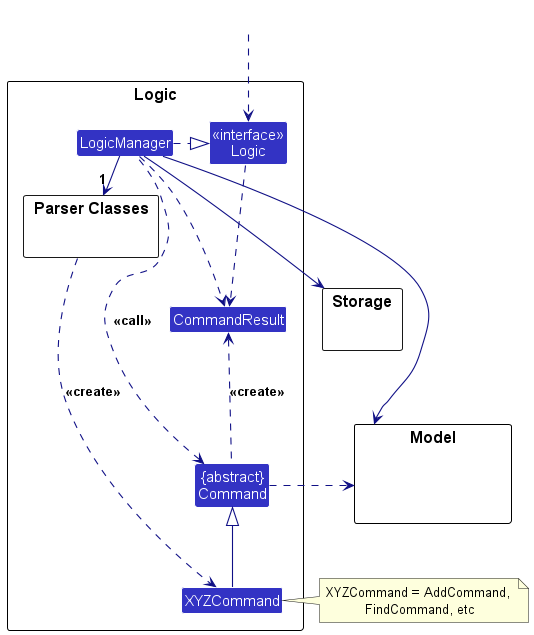
The sequence diagram below illustrates the interactions within the Logic component, taking execute("delete event 1") API call as an example.
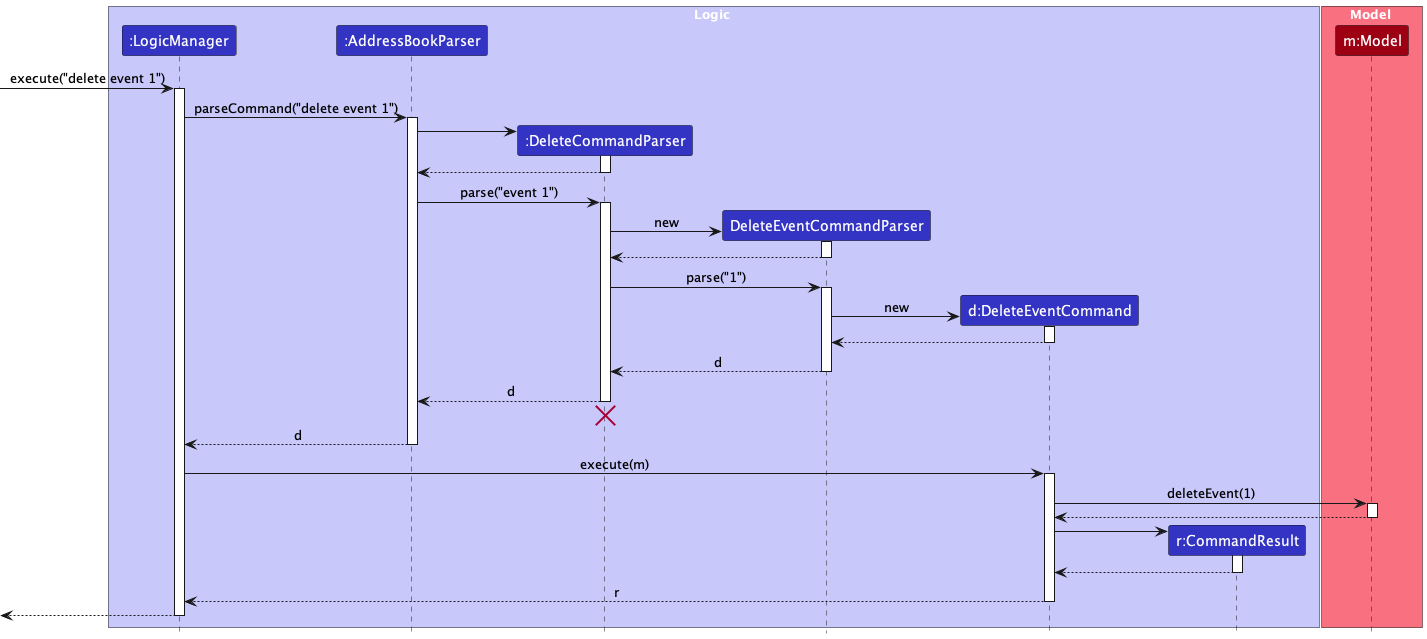
DeleteCommandParser should end at the destroy marker (X) but due to a limitation of PlantUML, the lifeline continues till the end of diagram.
How the Logic component works:
- When
Logicis called upon to execute a command, it is passed to anAddressBookParserobject which in turn creates a parser that matches the command (e.g.,DeleteCommandParser) and uses it to parse the command. - The
DeleteCommandParserparses the command and creates either aDeletePersonCommandParseror aDeleteEventCommandParserobject depending on the command type, which then parses the input. - This results in a
Commandobject (more precisely, an object of one of its subclasses e.g.,DeletePersonCommandorDeleteEventCommand) which is executed by theLogicManager. - The command can communicate with the
Modelwhen it is executed (e.g. to delete a person).
Note that although this is shown as a single step in the diagram above (for simplicity), in the code it can take several interactions (between the command object and theModel) to achieve. - The result of the command execution is encapsulated as a
CommandResultobject which is returned back fromLogic.
Here are the other classes in Logic (omitted from the class diagram above) that are used for parsing a user command:
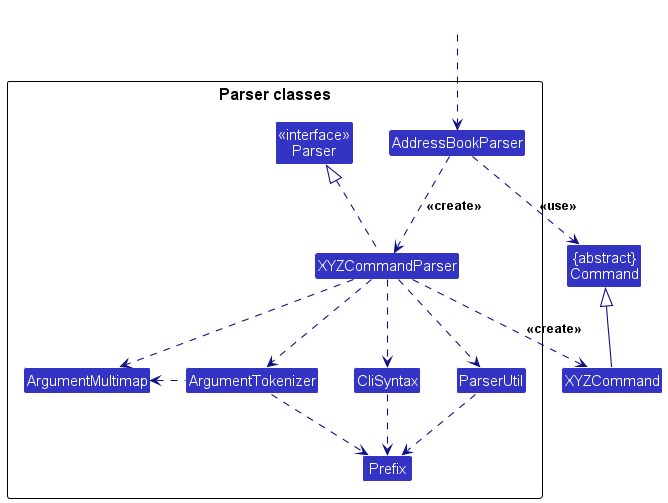
How the parsing works:
- When called upon to parse a user command, the
AddressBookParserclass creates anXYZCommandParser(XYZis a placeholder for the specific command name e.g.,AddCommandParser) which uses the other classes shown above to parse the user command and create aXYZEventCommandobject (e.g.,ClearCommand) which theAddressBookParserreturns back as aCommandobject. - All
XYZCommandParserclasses (e.g.,AddPersonCommandParser,DeletePersonCommandParser, …) inherit from theParserinterface so that they can be treated similarly where possible e.g, during testing.
Model component
API : Model.java

The Model component,
- stores the address book data i.e., all
PersonandEventobjects (which are contained inUniquePersonListandUniqueEventListobjects). - stores the currently ‘selected’
PersonandEventobjects (e.g., results of a search query) as a separate filtered list which is exposed to outsiders as an unmodifiableObservableList<Person>that can be ‘observed’ e.g. the UI can be bound to this list so that the UI automatically updates when the data in the list change. - stores a
UserPrefobject that represents the user’s preferences. This is exposed to the outside as aReadOnlyUserPrefobjects. - does not depend on any of the other three components (as the
Modelrepresents data entities of the domain, they should make sense on their own without depending on other components)
Tag list in the AddressBook, which Person references. This allows AddressBook to only require one Tag object per unique tag, instead of each Person needing their own Tag objects.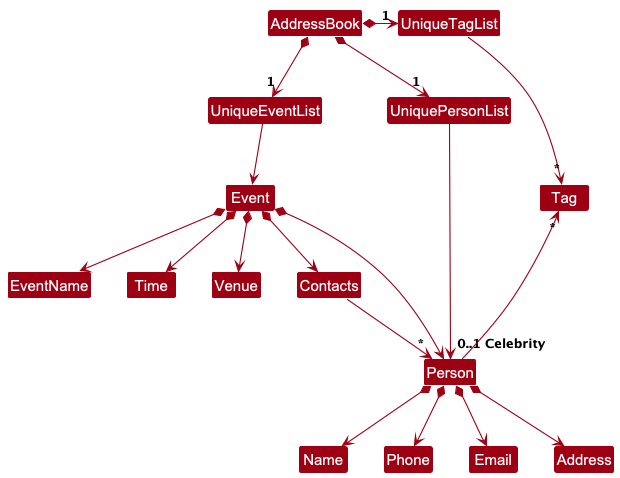
Storage component
API : Storage.java
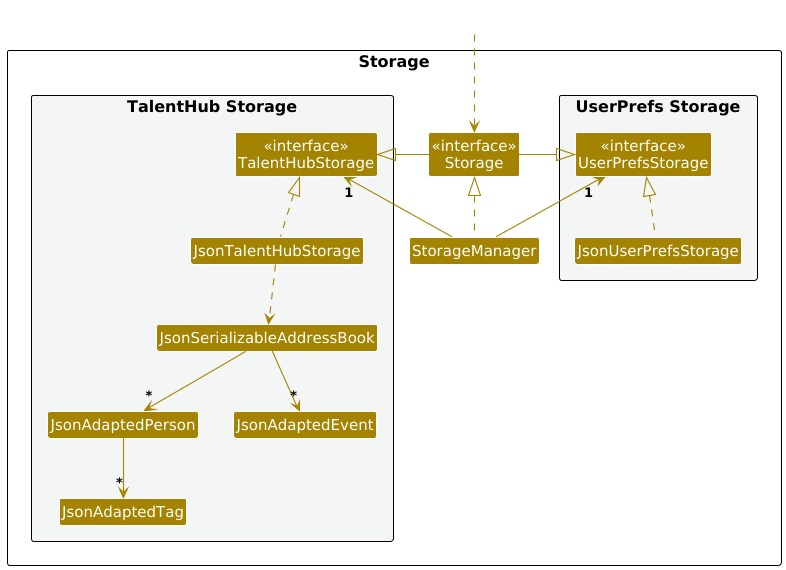
The Storage component,
- can save both address book data and user preference data in JSON format, and read them back into corresponding objects.
- inherits from both
AddressBookStorageandUserPrefStorage, which means it can be treated as either one (if only the functionality of only one is needed). - depends on some classes in the
Modelcomponent (because theStoragecomponent’s job is to save/retrieve objects that belong to theModel)
Common classes
Classes used by multiple components are in the seedu.address.commons package.
Implementation
This section describes some noteworthy details on how certain features are implemented.
Event and Person Synchronisation
Implementation
The current Event class has a Person field that stores the Person object associated with the event. This is because the Event object should be aware of the Person object it is associated with. This ensures that when details of the Person object are updated, the Event object is aware of the changes and can update itself accordingly. This applies to the contact list in Event as well.
Step 1: The user adds a new Event through the add event command. During execution of the command, the Person object associated with the Event is retrieved from the Model using the findPerson method.
The following sequence diagram shows how the Event object is created and associated with a Person object:
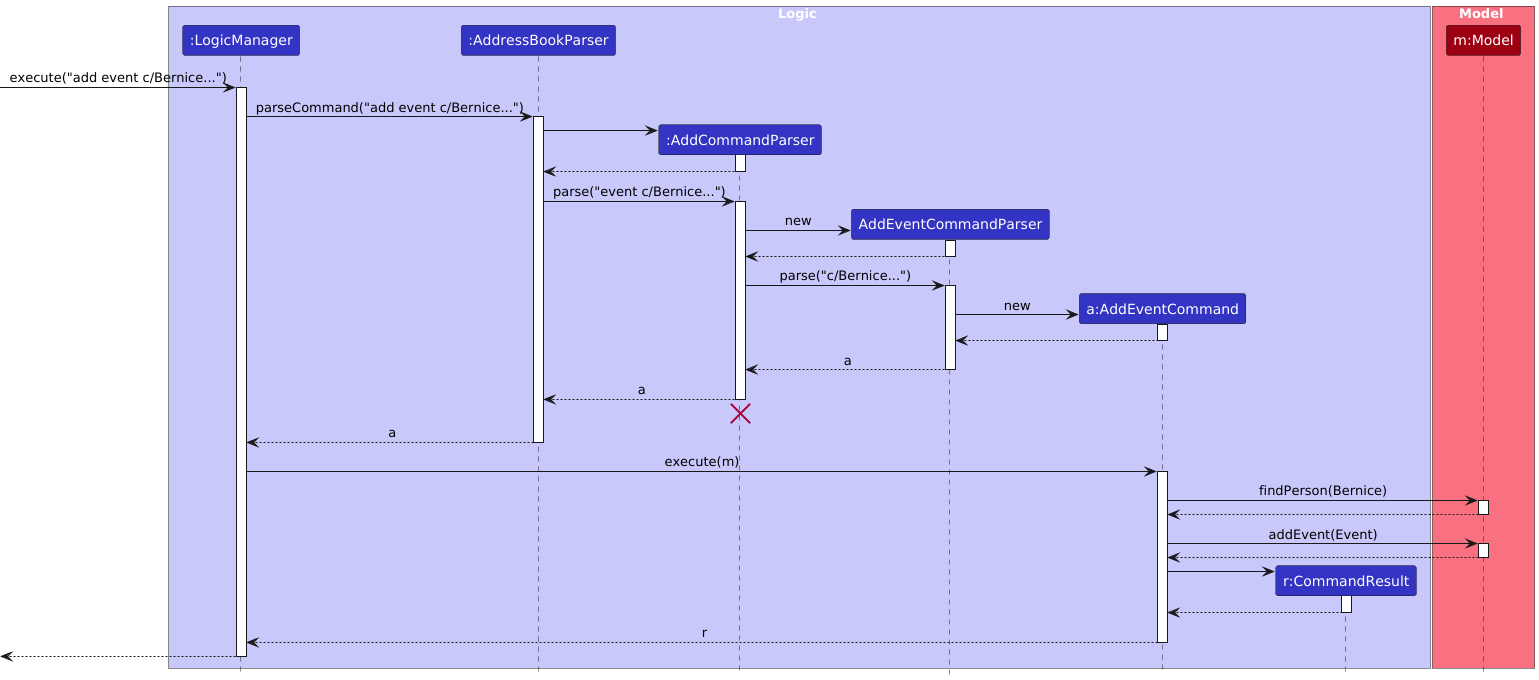
The following sequence diagram shows how findPerson method is executed and the Person object is retrieved:
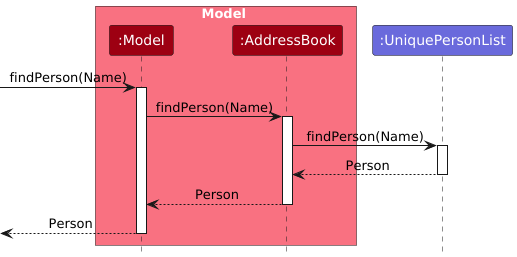
Step 2: The user updates the details of a Person object through the edit person command. During execution of the command, the updated Person replaces all original Person in relevant Events through the replacePersonInEvents method in the Model.
The following sequence diagram shows how the Person object is edited:
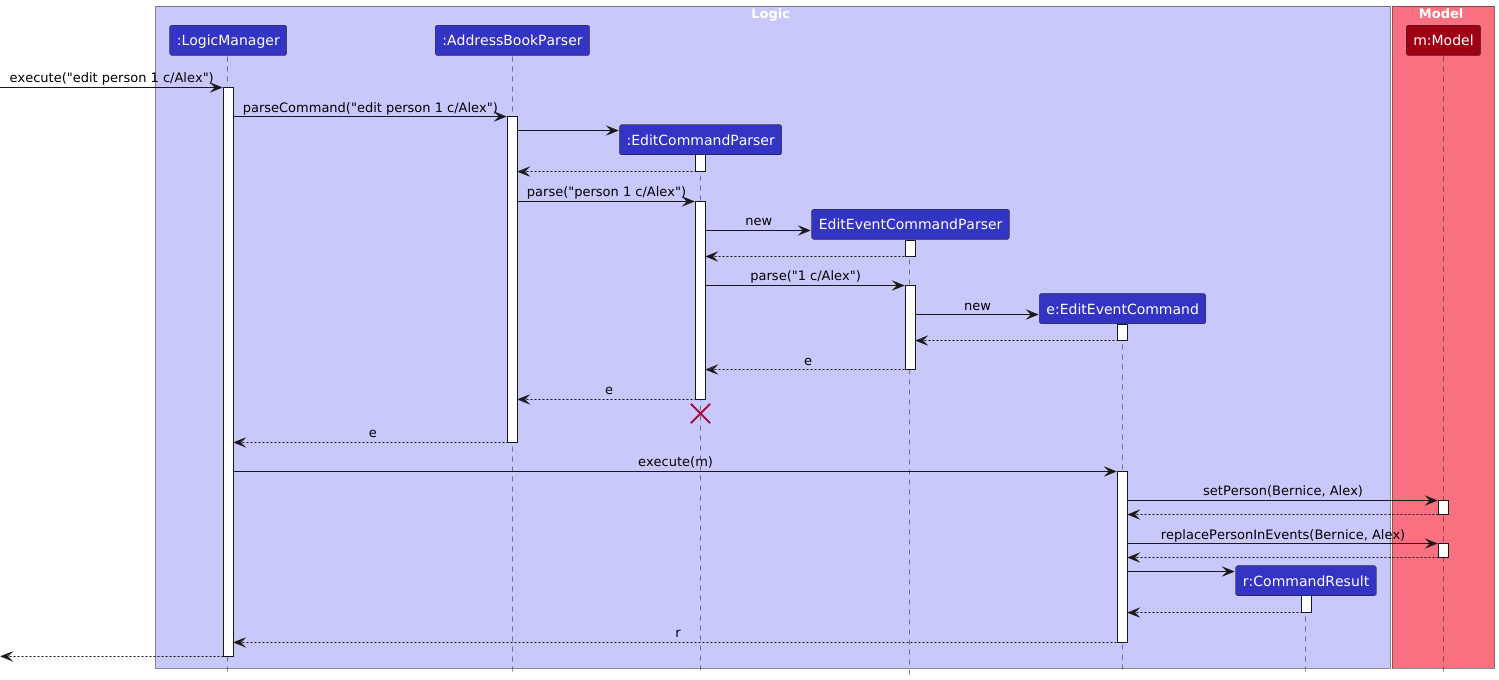
The following sequence diagram shows how replacePersonInEvents method is executed and the original Person object is replaced with the updated Person object:

[Proposed] Undo/redo feature
Proposed Implementation
The proposed undo/redo mechanism is facilitated by VersionedAddressBook. It extends AddressBook with an undo/redo history, stored internally as an addressBookStateList and currentStatePointer. Additionally, it implements the following operations:
-
VersionedAddressBook#commit()— Saves the current address book state in its history. -
VersionedAddressBook#undo()— Restores the previous address book state from its history. -
VersionedAddressBook#redo()— Restores a previously undone address book state from its history.
These operations are exposed in the Model interface as Model#commitAddressBook(), Model#undoAddressBook() and Model#redoAddressBook() respectively.
Given below is an example usage scenario and how the undo/redo mechanism behaves at each step.
Step 1. The user launches the application for the first time. The VersionedAddressBook will be initialized with the initial address book state, and the currentStatePointer pointing to that single address book state.
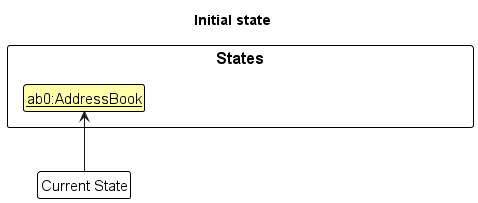
Step 2. The user executes delete person 5 command to delete the 5th person in the address book. The delete person command calls Model#commitAddressBook(), causing the modified state of the address book after the delete person 5 command executes to be saved in the addressBookStateList, and the currentStatePointer is shifted to the newly inserted address book state.
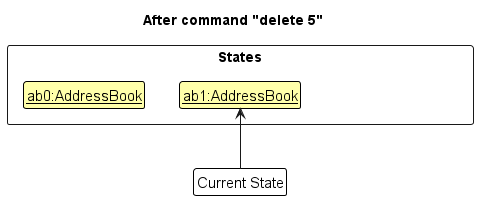
Step 3. The user executes add person n/David … to add a new person. The add person command also calls Model#commitAddressBook(), causing another modified address book state to be saved into the addressBookStateList.
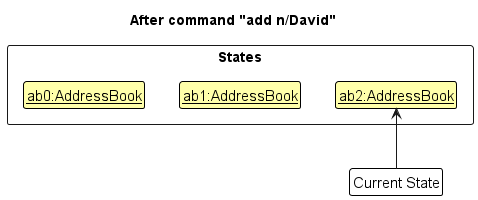
Model#commitAddressBook(), so the address book state will not be saved into the addressBookStateList.
Step 4. The user now decides that adding the person was a mistake, and decides to undo that action by executing the undo command. The undo command will call Model#undoAddressBook(), which will shift the currentStatePointer once to the left, pointing it to the previous address book state, and restores the address book to that state.
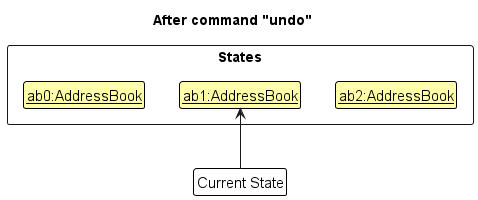
currentStatePointer is at index 0, pointing to the initial AddressBook state, then there are no previous AddressBook states to restore. The undo command uses Model#canUndoAddressBook() to check if this is the case. If so, it will return an error to the user rather
than attempting to perform the undo.
The following sequence diagram shows how an undo operation goes through the Logic component:
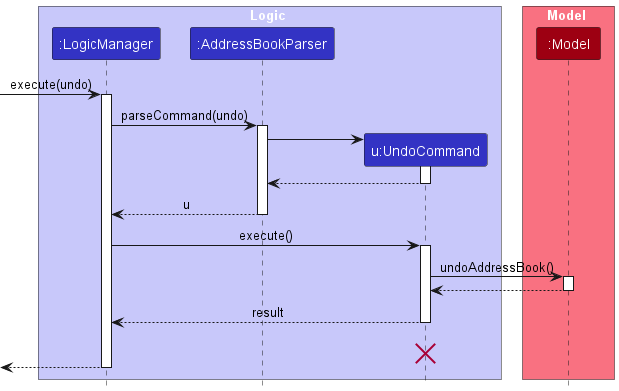
UndoCommand should end at the destroy marker (X) but due to a limitation of PlantUML, the lifeline reaches the end of diagram.
Similarly, how an undo operation goes through the Model component is shown below:
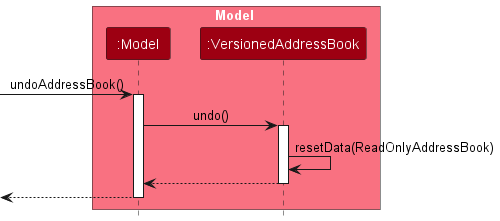
The redo command does the opposite — it calls Model#redoAddressBook(), which shifts the currentStatePointer once to the right, pointing to the previously undone state, and restores the address book to that state.
currentStatePointer is at index addressBookStateList.size() - 1, pointing to the latest address book state, then there are no undone AddressBook states to restore. The redo command uses Model#canRedoAddressBook() to check if this is the case. If so, it will return an error to the user rather than attempting to perform the redo.
Step 5. The user then decides to execute the command list person. Commands that do not modify the address book, such as list person, will usually not call Model#commitAddressBook(), Model#undoAddressBook() or Model#redoAddressBook(). Thus, the addressBookStateList remains unchanged.
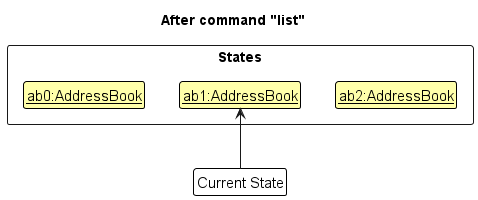
Step 6. The user executes clear, which calls Model#commitAddressBook(). Since the currentStatePointer is not pointing at the end of the addressBookStateList, all address book states after the currentStatePointer will be purged. Reason: It no longer makes sense to redo the add n/David … command. This is the behavior that most modern desktop applications follow.
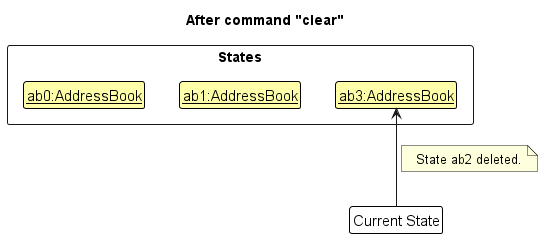
The following activity diagram summarizes what happens when a user executes a new command:
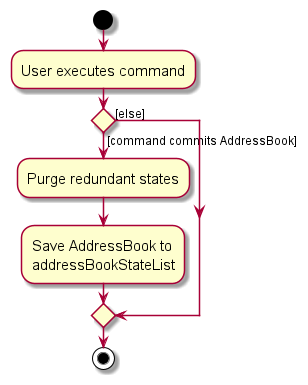
Design considerations:
Aspect: How undo & redo executes:
-
Alternative 1 (current choice): Saves the entire address book.
- Pros: Easy to implement.
- Cons: May have performance issues in terms of memory usage.
-
Alternative 2: Individual command knows how to undo/redo by
itself.
- Pros: Will use less memory (e.g. for
delete person, just save the person being deleted). - Cons: We must ensure that the implementation of each individual command are correct.
- Pros: Will use less memory (e.g. for
Documentation, logging, testing, configuration, dev-ops
Appendix: Requirements
Product scope
Target user profile: Celebrity Talent Managers
- have a need to manage a significant number of contacts (celebrities, industry professionals, etc)
- prefer desktop apps over other types
- can type fast
- prefer typing to mouse interactions
- are reasonably comfortable using CLI apps
Value proposition: TalentHub offers celebrity talent managers a secure, offline tool to manage various contacts and stakeholders, and schedule events efficiently. With editable fields, it streamlines coordination while ensuring privacy and data control in a high-stakes environment.
User stories
Priorities: High (must have) - * * *, Medium (nice to have) - * *, Low (unlikely to have) - *
| Priority | As a … | I want to … | So that I can… |
|---|---|---|---|
* * * |
Celebrity Talent Manager | add new contacts to my address book | keep track of important stakeholders |
* * * |
Celebrity Talent Manager | use command-line shortcuts to manage my contacts and schedule | work faster and more efficiently |
* * * |
Celebrity Talent Manager | delete a contact | remove entries that I no longer need |
* * * |
Celebrity Talent Manager | view details of a specific contact | quickly access specific information when needed |
* * * |
Celebrity Talent Manager | list my contacts | see an overview of my contacts |
* * * |
Celebrity Talent Manager | add important events | quickly view my important tasks |
* * * |
Celebrity Talent Manager | view the event details a client has | see and plan around their schedule |
* * * |
Celebrity Talent Manager | view all my events | have an overview of my timetable |
* * * |
Celebrity Talent Manager | delete an event | remove outdated entries |
* * * |
Celebrity Talent Manager | save my data | come back to it next time |
* * |
Celebrity Talent Manager dealing with various groups | group and tag my contacts | group contacts based on specific tags |
* * |
Celebrity Talent Manager with many contacts | search for clients using tags | quickly find individuals in a specific group |
* * |
Celebrity Talent Manager with many contacts | search for clients using names | quickly find specific individuals |
* * |
Celebrity Talent Manager | delete a contact only after confirmation | prevent accidental deletion of something still important |
* * |
Celebrity Talent Manager | edit contact information | update ay changes in their information |
* * |
Celebrity Talent Manager who can be forgetful | be alerted when I add duplicate entries | avoid duplicate entries |
* * |
Celebrity Talent Manager who is new to the application | access a help guide in the application | find out the command I need when I forget it |
* * |
Celebrity Talent Manager | perform mass deletion of entries | save time when I have to delete a lot of entries |
* * |
Celebrity Talent Manager | be alerted when events clash | identify clashes and resolve them easily |
* * |
Celebrity Talent Manager | mark events as over or ended | keep track my schedule |
* |
Celebrity Talent Manager | add a photo for my contacts | easily remember or recognise the contact |
* |
Celebrity Talent Manager | flag priority contacts | identify contacts that require immediate focus |
* |
Celebrity Talent Manager | export and import client data | safely transfer information on different devices |
* |
Celebrity Talent Manager who can be careless at times | undo my last command | quickly revert my changes when they are wrong |
* |
Celebrity Talent Manager | set reminders for tasks | get reminded of upcoming tasks that are due soon |
* |
Celebrity Talent Manager | set visual indicators for my contacts based on availability | quickly see if someone is available or not |
* |
Celebrity Talent Manager | customise my data storage location | change where my data is kept locally |
* |
Celebrity Talent Manager | set my own CLI shortcuts | use the commands faster based on my preferences |
Use cases
Use case: UC01 - Add Contact
MSS
- Talent Manager requests to add a specific contact
- TalentHub adds the person to the list
Use case ends.
Extensions
-
1a. The command format is incorrect.
-
1a1. TalentHub outputs a generic error message about incorrect command format.
Use case ends.
-
-
1b. Any compulsory parameter is missing or invalid.
-
1b1. TalentHub outputs an error message specifying the issue.
Use case ends.
-
-
1c. An identical name is detected.
-
1c1. TalentHub outputs an error message specifying the issue.
Use case ends.
-
-
1d. An identical phone number is detected.
-
1d1. TalentHub outputs an error message specifying the issue.
Use case ends.
-
Use case: UC02 - Edit Contact
MSS
- Talent Manager requests to edit the information of a specific contact
- TalentHub changes the information of the target person
Use case ends.
Extensions
-
1a. The command format is incorrect.
-
1a1. TalentHub outputs a generic error message about incorrect command format.
Use case ends.
-
-
1b. An identical name is detected.
-
1b1. TalentHub outputs an error message specifying the issue.
Use case ends.
-
-
1c. An identical phone number is detected.
-
1c1. TalentHub outputs an error message specifying the issue.
Use case ends.
-
Use case: UC03 - Delete Contact after List
MSS
- Talent Manager lists contacts (UC06)
- Talent Manager deletes contact (UC05)
Use case ends.
Use case: UC04 - Delete Contact after Find
MSS
- Talent Manager finds contact by name (UC07)
- Talent Manager deletes contact (UC05)
Use case ends.
Use case: UC05 - Delete Contact
MSS
- Talent Manager requests to delete a specific person in the list
- TalentHub requests for confirmation of deletion
- TalentHub deletes the person and all his/her corresponding events
Use case ends.
Extensions
-
1a. The command format is incorrect.
-
1a1. TalentHub outputs a generic error message about incorrect command format.
Use case ends.
-
-
1b. The list is empty.
-
1b1. TalentHub shows an index error message.
Use case ends.
-
-
1c. The given index is invalid.
-
1c1. TalentHub shows an index error message.
Use case ends.
-
-
2a. Talent Manager confirms the deletion.
- Use case resumes from step 3.
-
2b. Talent Manager cancels the deletion.
-
2b1. TalentHub outputs a successful cancellation message.
Use case ends.
-
-
2c. The parameter is missing or invalid.
-
2b1. TalentHub outputs an error message specifying the issue.
Use case resumes from step 2.
-
Use case: UC06 - List All Contacts
MSS
- Talent Manager requests to list contacts
- TalentHub shows a list of all contacts
Use case ends.
Extensions
-
1a. The command format is incorrect.
-
1a1. TalentHub outputs a generic error message about incorrect command format.
Use case ends.
-
Use case: UC07 - Find Contact by Name
MSS
- Talent Manager requests to find persons whose name contains
keywords - TalentHub processes and list person(s) whose name contains
keywords
Use case ends.
Extensions
-
1a. The command format is incorrect.
-
1a1. TalentHub outputs a generic error message about incorrect command format.
Use case ends.
-
-
1b. The keyword is empty.
-
1b1. TalentHub outputs an error message.
Use case ends.
-
Use case: UC08 - Filter Contact by Tag
MSS
- Talent Manager requests to filter persons with
tag - TalentHub processes and lists person(s) with
tag
Use case ends.
Extensions
-
1a. The command format is incorrect.
-
1a1. TalentHub outputs a generic error message about incorrect command format.
Use case ends.
-
-
1b. The keyword is empty.
-
1b1. TalentHub shows an error message.
Use case ends.
-
Use case: UC09 - Add Event
MSS
- Talent Manager requests to add an event for a specific celebrity
- TalentHub adds the event
Use case ends.
Extensions
-
1a. The command format is incorrect.
-
1a1. TalentHub outputs a generic error message about incorrect command format.
Use case ends.
-
-
1b. Any compulsory parameter is missing or invalid.
-
1b1. TalentHub outputs an error message specifying the issue.
Use case ends.
-
-
1c. A duplicate event is detected.
-
1c1. TalentHub displays a message informing the Talent Manager of the duplicate event and does not add it.
Use case ends.
-
-
1d. Time clash is detected.
-
1d1. TalentHub displays a message informing the Talent Manager of the time clash and does not add it.
Use case ends.
-
Use case: UC10 - Edit Event
MSS
- Talent Manager requests to edit the information of an event for a specific celebrity
- TalentHub changes the information of the event
Use case ends.
Extensions
-
1a. The command format is incorrect.
-
1a1. TalentHub outputs a generic error message about incorrect command format.
Use case ends.
-
-
1b. The input parameter is invalid.
-
1b1. TalentHub outputs an error message specifying the issue.
Use case ends.
-
-
1c. A duplicate event is detected.
-
1c1. TalentHub displays a message informing the Talent Manager of the duplicate event and does not change it.
Use case ends.
-
-
1d. Time clash is detected.
-
1d1. TalentHub displays a message informing the Talent Manager of the time clash and does not change it.
Use case ends.
-
Use case: UC11 - Delete Event after List
MSS
- Talent Manager lists events (UC14)
- Talent Manager deletes event (UC13)
Use case ends.
Use case: UC12 - Delete Event after Find
MSS
- Talent Manager finds event by name (UC15)
- Talent Manager deletes event (UC13)
Use case ends.
Use case: UC13 - Delete Event
- Talent Manager requests to delete a specific event from the list
- TalentHub deletes the event
Use case ends.
Extensions
-
1a. The command format is incorrect.
-
1a1. TalentHub outputs a generic error message about incorrect command format.
Use case ends.
-
-
1b. The list is empty.
-
1b1. TalentHub outputs an index error message.
Use case ends.
-
-
1c. The given index is invalid.
-
1c1. TalentHub outputs an index error message.
Use case ends.
-
Use case: UC14 - List All Events
MSS
- Talent Manager requests to list all events.
- TalentHub retrieves and displays all events in chronological order.
Use case ends.
Extensions
-
1a. The command format is invalid.
-
1a1. TalentHub outputs a generic error message about incorrect command format.
Use case ends.
-
Use case: UC15 - Find Event by Name
MSS
- Talent Manager requests to find event with name contains
keywords - TalentHub processes and list event with name contains
keywords
Use case ends.
Extensions
-
1a. The command format is invalid.
-
1a1. TalentHub outputs a generic error message about incorrect command format.
Use case ends.
-
-
1b. The keyword is empty.
-
1b1. TalentHub outputs an error message.
Use case ends.
-
Use case: UC16 - Filter Event by Celebrity
MSS
- Talent Manager requests to filter event by celebrity’s name
- TalentHub processes and lists target celebrity’s events
Use case ends.
Extensions
-
1a. The command format is incorrect.
-
1a1. TalentHub outputs a generic error message about incorrect command format.
Use case ends.
-
-
1b. The keyword is empty.
-
1b1. TalentHub outputs an error message.
Use case ends.
-
Use case: UC17 - Clear Events
- Talent Manager requests to clear all event in the list
- TalentHub requests for confirmation of clear
- TalentHub clears all events in the list
Use case ends.
Extensions
-
1a. The command format is incorrect.
-
1a1. TalentHub outputs a generic error message about incorrect command format.
Use case ends.
-
-
2a. Talent Manager confirms the clear.
- Use case resumes from step 3.
-
2b. Talent Manager cancels the clear.
-
2b1. TalentHub outputs an successful cancellation message.
Use case ends.
-
-
2c. The parameter is missing or invalid.
-
2b1. TalentHub outputs an error message specifying the issue.
Use case resumes from step 2.
-
Use case: UC18 - Clear Persons and Events
- Talent Manager requests to clear all persons and events in the list
- TalentHub requests for confirmation of clear
- TalentHub clears all persons and events in the list
Use case ends.
Extensions
-
1a. The command format is incorrect.
-
1a1. TalentHub outputs a generic error message about incorrect command format.
Use case ends.
-
-
2a. Talent Manager confirms the clear.
- Use case resumes from step 3.
-
2b. Talent Manager cancels the clear.
-
2b1. TalentHub outputs a successful cancellation message.
Use case ends.
-
-
2c. The parameter is missing or invalid.
-
2b1. TalentHub outputs an error message specifying the issue.
Use case resumes from step 2.
-
Non-Functional Requirements
- Should work on any mainstream OS as long as it has Java
17or above installed. - The software should work without requiring an installer.
- The software should not depend on a remote server.
- Since the app is intended to be an offline tool, it should function fully without any internet connection.
- The application should be packaged into a single JAR file.
- File sizes should be reasonable and not exceed the limits given below.
- Product (i.e., the JAR/ZIP file): 100MB
- Documents (i.e., PDF files): 15MB/file
- The developer guide and user guide should be PDF-friendly. Don’t use expandable panels, embedded videos, animated GIFs etc.
- The use of third-party libraries/frameworks/services should not be used so as to improve security and stability of the application.
- Talent managers with above average typing speed for regular English text (i.e. not code, not system admin commands) should be able to accomplish most of the tasks faster using commands than using the mouse.
- The application should prioritise one-shot commands over multi-step commands as they are faster. If a multi-step command is provided to help new users, a one-shot equivalent should also be provided for regular/expert users.
- Regular tasks (e.g., adding a contact, listing events) should be executable within a few milliseconds to maintain efficiency and not interrupt the talent manager’s workflow.
- The system should efficiently handle a large database of contacts and events (e.g., 1,000+ entries), allowing for fast searches, retrievals, and modifications without performance degradation.
- The data should be stored locally and should be in a human editable text file.
- The data should not be stored using a Database Management System.
- The data should be able to be loaded using a data file if the network is down.
- The system should provide a user-friendly and intuitive interface with clear instructions and feedback to guide talent managers who are not IT-savvy in using the command-line interface effectively.
- The GUI should work well (i.e., should not cause any resolution-related inconveniences to the user) for standard screen resolutions 1920x1080 and higher and for screen scales 100% and 125%.
- The GUI should be usable (i.e., all functions can be used even if the user experience is not optimal) for resolutions 1280x720 and higher and for screen scales 150%.
- As the app is an offline tool, it should be robust and able to run for extended periods without crashing. Downtime should be limited to under 1% (if any issues require restarting).
- The system should be able to recover from crashes within 5 seconds, ensuring minimal disruption to the talent manager’s workflow.
Glossary
- AddressBook: A structured data set containing contact and event information for Celebrities managed by Talent Managers.
- Events: Any type of activity organized by third parties which Celebrities are attending (e.g. Award Shows, Brand Events).
- Index: The position of individual contacts or events in lists referenced by specific commands.
- Industry Professional: Individuals that Celebrities interact with or service providers from whom Celebrities may need to procure services during events (e.g. Make-up artists, Directors).
- Logic Component: A part of the architecture responsible for handling and parsing user commands.
- Mainstream OS: Windows, Linux, macOS.
- Model Component: Manages the applications responsible for handling and parsing user commands.
- Model-View-Controller (MVC): A design pattern that separates an application into three main logical components: the Model, the View, and the Controller.
- ObservableList: A list that is monitored for changes, triggering updates to any UI components bound to it.
- Parser: A component that interprets and processes commands inputted by the user.
- Person: Refers to a contact object within TalentHub.
- Points of Contact (POCs): A list of persons involved in an event whom the talent manager may need to contact (e.g. Hairdresser, Stylist, Chauffeur).
- Sequence Diagram: A type of UML diagram that shows the order of interactions between objects in a particular scenario.
- Storage Component: Manages reading from and writing to the persistent storage.
- Tag: A descriptor associated with a contact, grouping them by common characteristics.
- (Celebrity) Talent Manager: A person involved in managing and planning Celebrity schedules.
- Undo/Redo Feature: Functionality that allows users to revert or reapply actions within the application.
- VersionedAddressBook: A class responsible for implementing the undo/redo feature by maintaining different states of the TalentHub
Appendix: Instructions for manual testing
Given below are instructions to test the app manually.
Launch and shutdown
-
Initial launch.
-
Download the jar file and copy into an empty folder.
-
Double-click the jar file Expected: Shows the GUI with a set of sample contacts. The window size may not be optimum.
-
-
Saving window preferences.
-
Resize the window to an optimum size. Move the window to a different location. Close the window.
-
Re-launch the app by double-clicking the jar file.
Expected: The most recent window size and location is retained.
-
Adding a person
-
Adding a person to TalentHub.
- Test case:
add person n/Alex Yeoh p/98765432 e/sydney@example.com a/311, Clementi Ave 2, #02-25 t/Celebrity.-
Expected
- A contact with the name ‘Alex Yeoh’ with the tag ‘Celebrity’ and phone number ‘98765432’ is added to the persons list.
- If you are on the Events tab, TalentHub will switch to the Persons tab.
-
Expected
- Test case: Add same person above.
- Expected: This person already exists in TalentHub.
- Test case: Add new person with same number as above.
- Expected: This phone number is already used by another person in TalentHub.
- Test case:
add person n/Alex Yeoh e/sydney@example.com a/311, Clementi Ave 2, #02-25 t/Celebrity.
-
Expected
- Invalid command format!
add person: Adds a person to the address book.
Parameters: n/NAME p/PHONE [e/EMAIL] [a/ADDRESS] [t/TAG]…
Example:add person n/Alex Yeoh p/98765432 e/sydney@example.com a/311, Clementi Ave 2, #02-25 t/Celebrity
- Invalid command format!
-
Expected
- Other incorrect add commands to try:
add person p/98765432 a/311, Clementi Ave 2, #02-25 t/Celebrity.
- Test case:
Deleting a person
-
Deleting a person while all persons are being shown.
-
Prerequisites: List all persons using the
list personcommand. Multiple persons in the list. Alex Yeoh at index 1. - Test case:
delete person 1.- Expected: Are you sure you want to delete this person? All events tied to this person will be deleted and this person will no longer show in any event’s contact list. (Y/N)
-
Input
Yory: Deleted Person:Alex Yeoh; Phone: 98765432; Email: sydney@example.com; Address: 311, Clementi Ave 2, #02-25; Tags: [Celebrity] -
Input
Norn: Pending command has been cancelled.
- Test case:
delete person 0-
Expected
- Invalid command format!
delete person: Deletes the person identified by the index number used in the displayed person list.
Parameters: INDEX (must be a positive integer).
Example:delete person 1
- Invalid command format!
-
Expected
- Other incorrect delete commands to try:
delete person,delete person x,...(where x is larger than the list size).
- Expected: Similar to previous.
-
Adding an event
-
Adding an event to TalentHub.
-
Prerequisites: Have 2 contacts for Alex Yeoh and Bernice Yu created in your Persons list.
- Test case:
add event n/Oscars t/2024-03-01 12:10 to 2024-03-01 18:30 v/Hollywood c/Alex Yeoh p/Bernice Yu-
Expected
- An event with the name ‘Oscars’ with the associated celebrity, duration and venue is added to the persons list.
- If you are on the Persons tab, TalentHub will switch to the Events tab.
-
Expected
- Test case: Add same event as above.
- Expected: This event already exists in TalentHub.
- Test case: Add new event with different event name but same celebrity name and clashing timing e.g.
t/2024-02-28 12:10 to 2024-03-01 18:30.- Expected: Alex Yeoh has another event that clashes with this event.
- Test case:
add event n/Oscars t/2024-03-01 12:10 to 2024-03-01 18:30 v/Hollywood c/Alex Yeoh p/Alex Yeoh.- Expected: Celebrity cannot be a contact in contact list.
- Test case:
add event n/Oscars t/2024-03-01 12:10 to 2024-03-01 18:30 v/Hollywood c/John Doe p/Bernice Yu.- Expected: John Doe not found in address book!
- Test case:
add event n/Oscars t/2024-03-01 12:10 to 2024-03-01 18:30 v/Hollywood c/Alex Yeoh p/John Doe.- Expected: John Doe not found in address book!
- Test case:
add event t/2024-03-01 12:10 to 2024-03-01 18:30 v/Hollywood c/Alex Yeoh p/Bernice Yu.-
Expected
- Invalid command format!
add event: Adds an event to the address book.
Parameters: n/NAME t/TIME [v/VENUE] c/CELEBRITY [p/CONTACTS]…
Example:add event n/Oscars t/2024-03-01 12:10 to 2024-03-01 18:30 v/Hollywood c/Alex Yeoh p/Bernice Yu p/David Li
- Invalid command format!
-
Expected
- Other incorrect add commands to try:
add event n/Oscars v/Hollywood c/Alex Yeoh p/Bernice Yuor any inputs that do not include a name, time or celebrity.
-
Deleting an event
-
Deleting an event while all persons are being shown.
-
Prerequisites: List all events using the
list eventcommand. Multiple events in the list. - Test case:
delete event 1.-
Expected: Deleted Event:
Oscars; Time: From: 2024-03-01 12:10 To: 2024-03-01 18:30; Venue: Hollywood; Celebrity: Alex Yeoh; Contacts: Bernice Yu - If you are on the Persons tab, TalentHub will switch to the Events tab.
-
Expected: Deleted Event:
- Test case:
delete event 0.-
Expected
- Invalid command format!
delete: Deletes the event identified by the index number used in the displayed event list.
Parameters: INDEX (must be a positive integer)
Example:delete event 1
- Invalid command format!
-
Expected
- Other incorrect delete commands to try:
delete event,delete event x,...(where x is larger than the list size).- Expected: Similar to previous.
-
Viewing a person
-
Viewing a person on TalentHub.
-
Prerequisites: List all persons using the
list personcommand. Multiple persons in the list. An entry with the person Alex Yeoh listed and no entries with person Bernice Yu listed. - Test case:
view person Alex Yeoh.- Expected: Alex Yeoh shown!
- TalentHub will display the detailed contact.
- Test case:
view person Bernice Yu.- Expected: Name not found in TalentHub!
- Test case:
view person.-
Expected
- Invalid command format!
view: Views the person whose name is the specified keywords (case-insensitive) and displays him/her.
Parameters: KEYWORD [MORE_KEYWORDS]…
Example:view person David Li
- Invalid command format!
-
Expected
- Other incorrect commands to try:
view person John Doeor any other contact names not found in TalentHub.
-
Viewing an event
-
Viewing an event on TalentHub.
-
Prerequisites: List all events using the
list eventcommand. Multiple events in the list. An entry with the event called Oscars listed and no entries with event Emmys listed. - Test case:
view event Oscars.- Expected: 1 events listed!
- TalentHub will display the detailed event.
- Test case:
view event Emmys.- Expected: 0 events listed!
- Test case:
view event.-
Expected
- Invalid command format!
view: Views the event whose name is the specified keywords (case-insensitive) and displays it.
Parameters: KEYWORD [MORE_KEYWORDS]…
Example:view event Awards show
- Invalid command format!
-
Expected
- Other incorrect commands to try:
view event Fashion Weekor any other events not found in TalentHub.
-
Finding a person
-
Finding a person on TalentHub.
-
Prerequisites: List all persons using the
list personcommand. Multiple persons in the list. Three entries with names starting with Alex listed. One entry with names starting with Bernice listed. No entries with names starting with David listed. - Test case:
find person Alex.- Expected: 3 persons listed!
- TalentHub will display the contacts that match the given keyword(s).
- Test case:
find person David.- Expected: 0 persons listed!
- Test case:
find person Sydney Bernice.- Expected: 4 persons listed!
- Test case:
find person.-
Expected
- Invalid command format!
find: Finds all persons whose names contain any of the specified keywords (case-insensitive) and displays them as a list with index numbers.
Parameters: KEYWORD [MORE_KEYWORDS]…
Example:find person Alex Bernice
- Invalid command format!
-
Expected
- Other incorrect inputs to try:
find person Johnor any other contact names not found in TalentHub.
-
Finding an event
-
Finding an event on TalentHub.
-
Prerequisites: List all events using the
list eventcommand. Multiple events in the list. Three entries with the name Oscars listed. One entry with the name Red Carpet. No entries with name Emmys listed. - Test case:
find event Oscars.- Expected: 3 events listed!
- TalentHub will display the events that match the given keyword(s).
- Test case:
find event Emmys.- Expected: 0 events listed!
- Test case:
find event Oscars Red.- Expected: 4 events listed!
- Test case:
find event.-
Expected
- Invalid command format!
find: Finds all events whose names contain any of the specified keywords (case-insensitive) and displays them as a list with index numbers.
Parameters: KEYWORD [MORE_KEYWORDS]…
Example:find event Emmys Oscars
- Invalid command format!
-
Expected
- Other incorrect inputs to try:
find event Red Carpetor any other events not found in TalentHub.
-
Filter a person
-
Filtering a person on TalentHub by tag.
-
Prerequisites: List all persons using the
list personcommand. Multiple persons in the list. Three entries with tags called Celebrity. No entries with tags called TwitchStreamer. - Test case:
filter person celebrity.- Expected: 3 persons listed!
- TalentHub will display the contacts with the given tag(s).
- Test case:
filter person TwitchStreamer.- Expected: 0 persons listed!
- Test case:
filter person.-
Expected
- Invalid command format!
filter: Filters the persons by the specified tag (case-insensitive) and displays it.
Parameters: TAG
Example:filter person Chauffeur
- Invalid command format!
-
Expected
- Other incorrect inputs to try:
filter person TikTokeror any other tags not found in TalentHub.
-
Filtering an event
-
Filtering an event on TalentHub.
-
Prerequisites: List all events using the
list eventcommand. Multiple events in the list. Three events with celebrity, Alex Yeoh. No events with celebrity, Bernice Yu listed. - Test case:
filter event Alex Yeoh.- Expected: 3 events listed!
- TalentHub will display the events with the given celebrity name(s).
- Test case:
filter event Bernice Yu.- Expected: 0 events listed!
- Test case:
filter event.-
Expected
- Invalid command format!
filter: Filters the events by the specified celebrity (case-insensitive) and displays it.
Parameters: NAME
Example:filter event Alex Yeoh
- Invalid command format!
-
Expected
- Other incorrect inputs to try:
filter event John Doeor any other contact names not found in TalentHub.
-
Editing a person
-
Editing a person on TalentHub.
-
Prerequisites: List all persons using the
list personcommand. Multiple persons in the list. - Test case:
edit person 1 p/91234567 e/johndoe@example.com.- Expected: Edited Person: Alex Yeoh; Phone: 91234567; Email: johndoe@example.com; Address: 311, Clementi Ave 2, #02-25; Tags: [Celebrity]
- Test case: Edit contact to have the same name as another contact.
- Expected: This person already exists in the address book.
- Test case: Edit contact to have the same number as another contact.
- Expected: This phone number is already being used by another person in TalentHub.
- Test case:
edit person.-
Expected
- Invalid command format!
edit person: Edits the details of the person identified by the index number used in the displayed person list. Existing values will be overwritten by the input values.
Parameters: INDEX (must be a positive integer) [n/NAME] [p/PHONE] [e/EMAIL] [a/ADDRESS] [t/TAG]…
Example:edit person 1 p/91234567 e/johndoe@example.com
- Invalid command format!
-
Expected
- Other incorrect inputs to try:
edit person 0or any other edit command with inputs of the wrong format.
-
Editing an event
-
Editing an event on TalentHub.
-
Prerequisites: List all persons using the
list eventcommand. Multiple persons in the list. - Test case:
edit event 1 t/2024-03-01 13:10 to 2024-03-01 19:30 v/Broadway c/Bernice Yu p/Alex Yeoh.- Expected: Edited Event: Emmys; Time: From: 2024-03-01 13:10 To: 2024-03-01 19:30; Venue: Broadway; Celebrity: Bernice Yu; Contacts: CelebrityAlex Yeoh 90765432
- Test case: Edit event to have same details as another event.
- Expected: This event already exists in TalentHub.
- Test case: Same celebrity has clashing events e.g.
edit event 2 t/2024-03-01 13:10 to 2024-03-01 19:30 v/Broadway c/Bernice Yu p/David Lee.- Expected: Bernice Yu has another event that clashes with this event!
- Test case: Celebrity is both celebrity and contact e.g.
edit event 2 p/Bernice Yu.- Expected: Celebrity cannot be a contact in contact list!
- Test case:
edit event.-
Expected
- Invalid command format!
edit event: Edits the details of the event identified by the index number used in the displayed event list. Existing values will be overwritten by the input values.
Parameters: INDEX (must be a positive integer) [n/EVENT NAME] [t/TIME] [v/VENUE] [c/CELEBRITY]…
Example:edit event 1 t/2024-03-01 13:10 to 2024-03-01 19:30 v/Broadway c/David Li p/Alex Yeoh
- Invalid command format!
-
Expected
- Other incorrect inputs to try:
edit event 0or any edit event command with inputs in the wrong format.
-
Appendix: Planned Enhancements
Team size: 5
- Undo/Redo Feature: Implement an undo/redo feature for the TalentHub application. This feature will allow users to undo or redo their last action, providing a safety net for accidental deletions or modifications.
- Add check for overlapping dates and valid times when deserializing: Implement a check for overlapping dates and valid times (start time before end time) when deserializing the data from the storage file. This will ensure that the data is consistent and accurate when loaded into the application.
-
Add support for accepting empty prefix for tags and contacts during
add personandadd eventcommands: Modify the application to recognize an empty prefix for tags and contacts when using theadd personandadd eventcommands. This will allow users to specify no tags or points of contacts when adding a person or event. - Add support for choosing or viewing multiple tags for contacts in events: Enhance the application to allow users to choose or view multiple tags for contacts in events in the GUI. This will provide more flexibility in managing contacts and events with different categories or groups.
- Add case-sensitive duplication check for names: Implement case-sensitive validation for names when adding or editing persons and events. This will ensure that names are stored and displayed consistently in the application.
- Add feature which programmatically discerns if a person is a celebrity or industry professional: Implement a feature that programmatically discerns if a person is a contact or a celebrity. Only celebrities would be allowed to be added as the celebrity in an event.
- Add stricter validation for names: Only allow names to contain alphabets, spaces, and special characters like hyphens and apostrophes. Names should not contain numbers or other special characters.